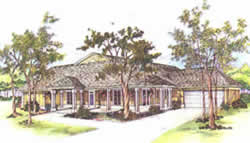
![]()
 |
The following home design brochure is available in PDF format. Adobe Acrobat Reader is required to view it. You may download it for free by clicking on the image below.
![]()
Making a home climate-friendly in hot, humid florida is a challenge to any architect or designer. It takes a solid understanding of the state's environmental realities, appropriate energy-efficient design strategies, home-owner tastes and preferences, and the value of good construction practices.
The Florida Governor's Energy Office sponsored the 1989 Energy-Efficient Florida Home Design Competition to encourage energy-efficiency in new Florida homes. The goals of the contest were to select the most climate-friendly home designs that the state's residential design community had to offer, and to make winning plans available to all Floridians at low cost.
The Florida Solar Energy Center coordinated the competition, soliciting entries from professional architects, designers and architectural students statewide. Robin Vieira, the program administrator, developed evaluation criteria that accounted for energy-efficiency, aesthetics and construction value.
Entries were judged by a team of experienced professionals.: Michael Bier, Architect; Elaine Burbage, Building Inspector Supervisor; Richard Malin, Builder and General Contractor; Alexander Ratensky, director, FAMU/USF Architecture PRogram; and Madie Rider, Architect. The construction cost of each entry was reviewed by Gary Cook, a building construction specialist with the state's Energy Extension Service.
These award-winning designs all include radiant barriers and ridge vents; fans in all living and sleeping areas; air distribution equipment in conditioned space; and structural shading of windows.
Before you select a plan, determine the orientation of your lot. Two of these plans, Garden Place and Sunburst, are orientation independent — their energy efficient features don't depend on which way the building faces. However, Shady Haven was specifically designed for a lot that faces north or south, and Sea Breeze for a lot that faces east or west. Their energy-efficient design aspects depend on those orientations. Orienting them in another direction could result in reduced comfort and higher energy bills.
Survey your lot first. Your site may offer interesting views or mature trees that would have to be sacrificed for one of these plans. If that's the case, you may want to consult a designer or architect to develop your own home design — one that takes best advantage of your lot's natural aspects.
Other things to consider include construction practices, appliance selection, and occupancy patterns. Even the most energy-efficient home design will not offer energy savings if you ignore any one of these points.
The Florida Solar Energy Center has compiled a book called Energy-Efficient Florida Home Building, which presents the most energy-efficient construction practices. It also discusses energy-efficient appliances and amenities. The publication, which is available online (click here), may be of great interest to you and your builder.
To order complete plans for any of these award-winning home design, fill out the order form and send it with a check for the appropriate amount to the Florida Solar Energy Center. Each set includes, floor, foundation and roof plans; all elevations; important sections; kitchen and bath details; window and door schedules; and mechanical, electrical and plumbing diagrams.
 Garden
Place (2,126 kb) Garden
Place (2,126 kb) |
 Sea
Breeze (2,003 kb) Sea
Breeze (2,003 kb) |
 Shady
Haven (1,721 kb) Shady
Haven (1,721 kb) |
 Sunburst (2,038 kb) Sunburst (2,038 kb) |
